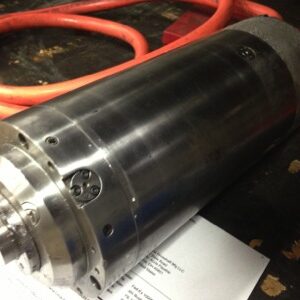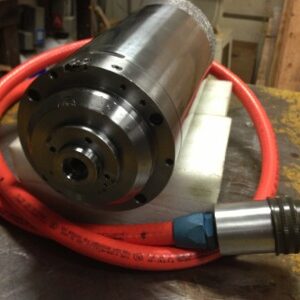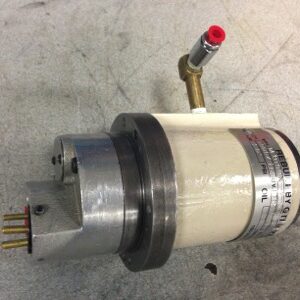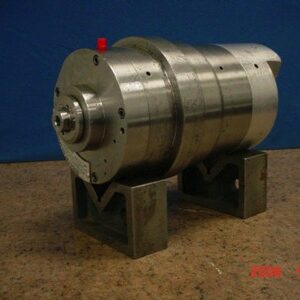Our Bryant spindle repair process is incomparable in quality and efficiency. Our highly trained technicians have in-house resources that are state of the art. We have full access to parts as well as complete manufacturing capabilities that allows us to repair your machine tool spindle properly the very first time—that’s why we offer a one-year guarantee on our work. GTI is the spindle company for your BRYANT sales, service and repair requirements.
*Bryant is a registered trademark of Fives Landis Corp. GTI is not affiliated with Bryant. We do however provide parts and services to support end users of Bryant machine tools and spindles.
Bryant Spindle Re-manufacturing Services
Analysis
Our technicians thoroughly inspect the spindle to identify the problem correctly before moving ahead with any spindle repair work. All spindles are subjected to the following 5 point assessment:
Incoming Vibration Analysis
- Incoming vibration analysis is performed in order to determine: bearing condition, level of unbalance, non-repetitive runout.
Assembled Spindle Inspection
- Pilot ID or taper runout on tool end of shaft to determine possible spindle crash or improper tooling.
- Rear taper runout inspection to determine possible over tightening of belts or improper tooling.
- Preload test to determine bearing wear or spindle crash.
Disassembled Spindle Inspection
- Pilot ID or taper inspection to determine spindle crash, improper tooling or overheating. Bearing journal inspection to determine improper bearing fits or use of spindle after initial failure.
- Overall shaft condition to determine crash, overheating, lack of coolant or overloading.
Bearing Condition
- An inspection of bearings is performed under lab conditions by factory trained bearing specialists to determine lack of lubrication, over speeding, spindle crash, overloading, loss of preload, contamination (coolant or other material) or overheating due to electrical problems. We have access to all bearings regardless of bearing OEM as well as the bearing OEM’s engineering and personnel support regardless of the machine tool or spindle manufacturer.
Engineering Recommendations
- We recommend spindle design changes or enhancements to improve spindle longevity and/or performance. For example, if a spindle has failed due to contamination, a design change such as new labyrinth nuts, air purging, hybrid bearings or improved sealing design will be recommended and implemented.
What GTI Provides
Removal
- The spindle needs to be removed from the grinding machine. Removal can be done either by the customer themselves or by GTI technicians who can be sent to the client’s site for removal of the spindle.
Repair
- Post planning of Bryant spindle repair corrective actions, rebuilding as well as preventative maintenance work advice is given which needs to be taken care of before installing the spindle back into the machine.
Testing
- The spindles are tested to check if all the machine interface parts such as encoders, proximity switches etc. are functioning properly and all spindles have to pass the vibration analysis and review of an autonomous GTI QC manager.
Reinstallation
- Bryant machine tool spindle post repair are reinstalled and checked for performance and reliability; which can be executed upon customer request by a GTI technician. Detailed documentation of the repair work is provided to all GTI customers.
GTI can repair spindles from the following Bryant grinding machine lines
Bryant Model B+
- Our year old service guarantees to that your tools will be repaired to bring you back your normal operation. With our service, you will again be able to produce maximum output with your repaired grinding machines. The rate of rotation is very high at 150,000 rpm.
Bryant Ultraline (UL1)
- Our specialized and skilled technicians will assure you that you can extract the maximum profit by using our products. The high performance internal grinder is able to produce high benefit and the size ranges from 0.04†to 1.25†with precision.
Bryant Ultraform (UF1)
- We assure you 100% accuracy with a greater speed while you purchase our products. Any difficulties will be treated with extensive care by our expert professionals. We have a very highly skilled ad qualified team of technicians who will take care of your troubles. The work portion is from 0.160†to 3.14â€. We maintain a standard in our works and that is the reason why you like us. With your support we are now a leading provider in the field.
Our Bryant spindle repair and spindle rebuild comes with a one-year warranty. This warranty starts from the day of installation on the machine, not the day of shipment like many of our competitors. Call us to arrange your Bryant spindle repair and to get your spindle back into production. Think you need a Bryant spindle replacement or repair? Call to discuss your options. Toll free: 888-473-9675 GTI Spindle Technology
Showing all 11 results
-

Bryant 403H18-1 Spindle
$0.00 Add to cart -

Bryant 40K Spindle
$0.00 Add to cart -

Bryant 932C Spindle
$0.00 Add to cart -

Bryant BZ-24 Spindle
$0.00 Add to cart -

Bryant HA8403H18-1 Spindle
$0.00 Add to cart -

Bryant HD 109 B Spindle
$0.00 Add to cart -

Bryant M1090X-1 Spindle
$0.00 Add to cart -

Bryant MVC-854S Spindle
$0.00 Add to cart -

Bryant MVC-855S Spindle
$0.00 Add to cart -

Bryant MVC-856S Spindle
$0.00 Add to cart -

Bryant WBA 2971 Spindle
$0.00 Add to cart